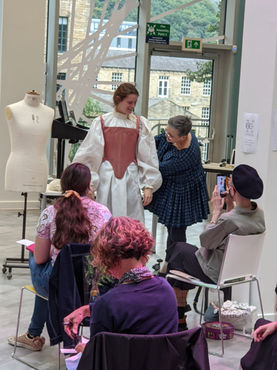Constructing Costume Histories: Online Symposium
30 April 2021
Our inaugural event, a free online symposium held over Zoom, represented the culmination of more than a year of planning, anticipation, and pandemic-related delays.
Our speakers represented a range of costume, performance, and educational instititions and their papers emphasised the diversity of innovative new research being undertaken at the nexus of costume, making, and history.
International appetite for the event was surprising and encouraging. Within three days of announcing our programme we were delighted to find we had sold out; some 250 tickets had been snapped up by researchers, makers, and students from around the world.
The event generated a series of exciting conversations which carried on beyond the symposium, across Twitter, Instagram and email over the following months.
Programme
Rebecca Morrison, QMUL
And Dresses by Miss Rein
Liz Garland, University of Huddersfield
In the Eye of the Deceiver
Amy Hare, UAL Wimbledon
Corsets, Crinolines and Modernity: The Enduring Legacy of Jeanetta Cochrane, Norah Waugh, Margaret Woodward and the Central School of Art
Toni Bate, Liverpool Institute for Performing Arts (LIPA)
Open to Interpretation: The Reconstruction of Historical Theatrical Costume
Stephanie Blythman, Independent
Contact tracing: finding the networks between actors, textile merchants, and tailors in 17th Century Paris
KEYNOTE: Jenny Tiramani, The School of Historical Dress:
A Quest for the Holy Grain via the Land of Serendip
Constructing Costume Histories: Study Day
University of Huddersfield
24 September 2021
Kindly supported by the Pasold Research Fund, the Society for Theatre Research, and the University of Huddersfield
Following the success of our online symposium and the concurrent relaxing of pandemic restrictions in the UK, we invited our symposium speakers and other costume-making experts to join us at the University of Huddersfield’s magnificent Barbara Hepworth building for a study day examining how we can bring the history of costume construction to life through practice and interaction with wider audiences.
Costume is, after all, a vibrant and living culture of making and doing, and celebration of that is central to our project’s aims. As such, we wanted our speakers to have freedom to present their research in action, however they thought best. We were treated to a packed schedule of fantastic practical workshops and demonstrations and were able to participate in each: handling objects, examining techniques, and debating what constitutes the perfect tool kit for the professional costume maker.
Programme
Amy Hare had the whole audience sharpening their pencils to take part in Making History: Costume Making as Scholarship in Post-War Britain, an interactive session structured around close examination and drawing of costume objects to reframe practice as an important form of history scholarship.
Lauren Martin presented Beyond the Needle and Thread: The Intangible Elements of Costume Making in which she set up a mini-bonnet-making workroom complete with kit, materials, and finished bonnets to consider the critical but intangible elements (not least skill, expertise, and experience) that make costume ‘magic’.
Liz Garland and Toni Bate were in conversation on the theme of To Zip or Not to Zip?, a lively and frank discussion about standards and requirements in making costume for live performance. Structured around various examples of stage costume, Liz and Toni considered the demands placed on working costumes and how these feed into and are influenced by the many skills of the professional costume maker.
Stephanie Blythman took us on a tour of the theatrical melting pot of 17th century Paris, with her presentation, Contact Tracing: Finding the Networks Between Actors, Textile Merchants and Tailors in 17th Century Paris, stopping off at various points to consider how the haptic, practical knowledge of the costume maker can be combined with traditional research methodologies in history to broaden and enrich our understanding of costume and performance.
Rebecca Morrison brought her research and costume expertise together in (Re)making as Method: Different Approaches to Reconstructing Historic Garments, a practical session in which she first considered how to undertake close observation of objects, and then how to build on this using practice-led research. Rebecca reflected on her own experience of re-making early eighteenth-century dress to uncover answers to intangible questions of method, skills, and techniques through haptic experience.
Jenny Tiramani concluded the day in style with her session, When is a Costume not a Costume?. Through reflections on a long career in and out of costume, Jenny used a range of case studies and objects to challenge our understanding of what we consider to be ‘costume’. Participants were treated to a handling session of various objects, the opportunity to be dressed in costumes made through exacting historical research, and were inspired to begin their own adventures in costume research with small, individual sewing kits from The School of Historical Dress.







